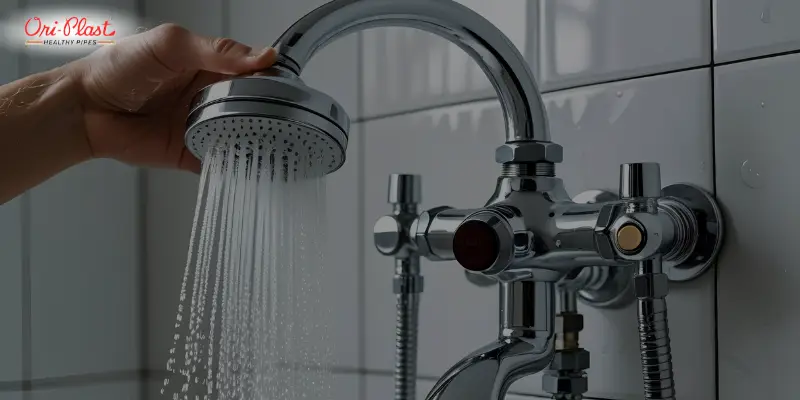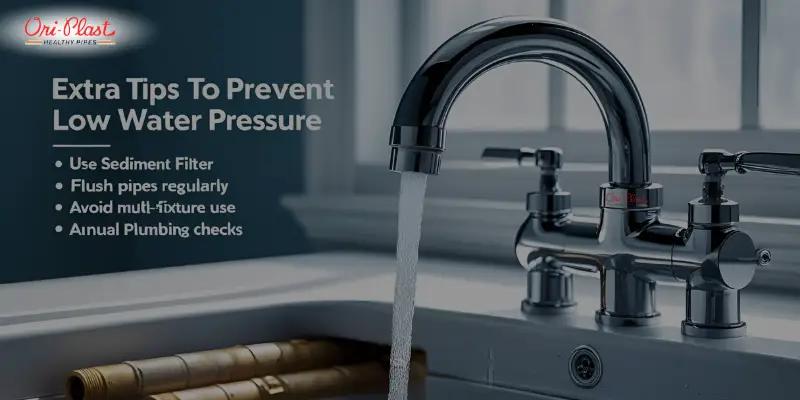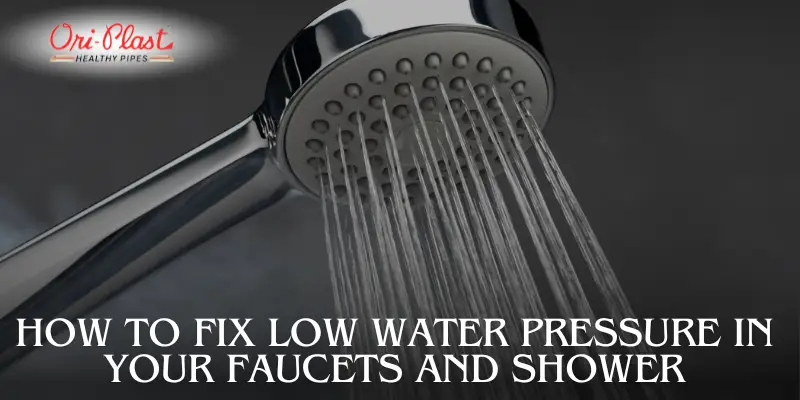Why Does Low Water Pressure Happen?
Before we dive into the solutions, let’s look at the possible causes. Knowing what’s causing the issue will help you choose the right fix.1. Clogged Faucet Aerators and Showerheads
Minerals and debris from hard water can build up inside the small holes of your faucet or showerhead, blocking water flow. This is one of the most common reasons for low water pressure in homes.2. Partially Closed Valves
Your home’s water supply has different valves. If the main valve or supply valves near your faucets are not fully open, it can reduce water pressure.3. Leaking Pipes
Water leaks in your plumbing system can reduce pressure at the faucet or shower. Even a small leak can make a big difference.4. Old or Rusted Pipes
Over time, old metal pipes can rust or collect mineral buildup inside. This reduces the space for water to flow and causes low water pressure throughout the home.5. Pressure Regulator Issues
Some homes have a pressure regulator to control how much pressure enters the house. If this device is faulty, your entire home may suffer from low water pressure.6. City Water Supply Problems
Sometimes, the problem comes from outside your home. Your local water supply may have low pressure during repairs or peak usage times.How to Fix Low Water Pressure – Step-by-Step Guide
 Now that you know what can cause low water pressure, here’s a simple guide on how to fix low water pressure in your faucets and shower.
Now that you know what can cause low water pressure, here’s a simple guide on how to fix low water pressure in your faucets and shower. Step 1: Clean Your Faucet and Showerhead
What to do:- Remove the aerator from your faucet or unscrew your showerhead.
- Soak the components in vinegar for several hours to dissolve and remove mineral deposits.
- Rinse and scrub gently using a toothbrush.
- Reinstall and test the water flow.
Step 2: Open All Water Valves
Make sure your main water valve and all supply valves under sinks are fully open. If a valve is only partially open, it can restrict water flow and cause low pressure. Tip: Turn the valve counterclockwise until it stops to fully open it.Step 3: Check for Leaks
Leaks can waste water and lower pressure. Look for signs of water damage, damp walls, or puddles under sinks. You can also check your water meter. If it keeps moving when all taps are closed, you may have a hidden leak. Fix it: Call a plumber or replace leaking pipes with new, durable ones.Step 4: Test Your Pressure Regulator
If you’re experiencing low water pressure throughout your entire house, a faulty pressure regulator could be the cause. How to check:- Purchase a water pressure gauge from your local hardware or home improvement store.
- Attach it to a hose outlet or faucet.
- If the reading is below 40 PSI, you might need to adjust or replace the regulator.
Step 5: Replace Old or Narrow Pipes
If your home has old metal or galvanized pipes, internal rust buildup can narrow the pipe’s diameter and significantly reduce water flow. Solution: Upgrade to modern PVC pipes like CPVC or UPVC, which are rust-free and support smooth, strong water flow. OriPlast pipes are a great example—they are easy to install and built to handle pressure.Permanent Fix: Upgrade Your Plumbing System
If you’ve tried the steps above and still face low water pressure, your plumbing system may need an upgrade. Homes over 20 years old often have outdated plumbing that no longer meets modern water usage needs.Benefits of Upgrading:
- Better Water Flow: New pipes have smoother inner walls that let water move freely.
- No Rust or Corrosion: UPVC and CPVC pipes don’t rust or scale.
- Leak-Free Joints: New systems reduce the chances of pressure loss from leaks.
- Hot and Cold Water Ready: Modern plumbing materials can handle both high and low temperatures.
Extra Tips to Prevent Low Water Pressure
 To keep your water pressure steady in the long run, follow these simple tips:
To keep your water pressure steady in the long run, follow these simple tips: 1. Use a Sediment Filter
Install a filter at your main water line to stop dirt and debris from entering your plumbing system.2. Flush Pipes Regularly
If you live in a hard water area, flush your pipes every few months to remove any buildup.3. Avoid Using Many Fixtures at Once
Using washing machines, dishwashers, and showers all at the same time can lower pressure. Try to spread out usage.4. Choose Water-Efficient Fixtures
Modern taps and showerheads use less water but maintain pressure by mixing air into the stream.5. Do Annual Checks
Inspect your valves, pipes, and fittings every year to catch problems early.6. Upgrade to a Smart Shower
Smart showers optimize water use without compromising pressure. They feature smart flow control and help maintain steady pressure even in low-flow situations.
Discover the benefits of smart showers
Conclusion
Low water pressure is more than just an annoyance—it can affect your daily comfort and signal deeper plumbing problems. Luckily, by following a few simple steps and understanding how to fix low water pressure, you can restore good water flow in your home. From cleaning showerheads to checking valves and replacing old pipes, there are many ways to improve water pressure without major costs. If you want a long-term solution, upgrading to high-quality plumbing products like those OriPlast offers is smart. With the right approach and the right materials, you’ll never have to deal with low water pressure again. Need expert plumbing solutions? Choose OriPlast for quality pipes and fittings that keep your water flowing strong, every day.FAQs: Fixing Low Water Pressure in Your Home
Q1: What causes low water pressure in faucets and showers?
A: Common causes include clogged aerators or showerheads, partially closed valves, leaking pipes, old rusted pipes, faulty pressure regulators, and issues with the city water supply.
Q2: How can I check if my faucet or showerhead is clogged?
A: Remove the aerator or showerhead, soak it in vinegar for several hours to dissolve mineral buildup, then clean with a brush before reinstalling.
Q3: What should I do if my water pressure is low throughout the entire house?
A: It might be due to a faulty pressure regulator or old pipes. You can test pressure using a water pressure gauge and consider replacing outdated plumbing with modern pipes like CPVC or UPVC.
Q4: Can leaking pipes cause low water pressure?
A: Yes, even small leaks can reduce water pressure by letting water escape before it reaches your faucets or showers.
Q5: How do I know if my pipes need replacement?
A: Signs include rust inside metal or galvanized pipes, frequent leaks, or consistently low water pressure despite other fixes.
Q6: What types of pipes are best to upgrade to?
A: Modern PVC pipes, such as CPVC or UPVC, are rust-free, durable, and ensure better water flow. Brands like OriPlast offer quality plumbing solutions.
Q7: Is there an easy way to improve water pressure without replacing pipes?
A: Cleaning aerators, opening valves fully, fixing leaks, and checking the pressure regulator can help improve pressure without major plumbing work.
Q8: How often should I maintain my plumbing system to avoid low water pressure?
A: Inspect valves, pipes, and fixtures annually and flush pipes every few months if you have hard water.
Q9: Can using multiple water fixtures at the same time lower water pressure?
A: Yes, running many appliances simultaneously can reduce water pressure. Try to stagger use of washing machines, dishwashers, and showers.
Q10: Should I hire a professional plumber for water pressure issues?
A: For complex problems like pressure regulator replacement or pipe upgrades, it’s best to consult a licensed plumber.


